This article is aimed to help broaden the brain on crabbing and all its attributes. I will start off by giving you a few hints on the gear you will need and use on a daily basis when crabbing.
Our two main targets are mud and sand crabs.
The difference between a mud crab pot and a sand crab pot is, well, nothing. One pot is designed to do it all, however, there are quite a few pot designs to choose from.
You can design your own out in your back yard shed with a bit of mesh and some handy work. You can get them tailor-made to your very own specks, such as 2 entry, 4 entry, entry depth, chafe ropes, bait bags, width of pot, depth of pot, diameter of gall ring, you name it and it can be done – at a cost, of course. Alternatively, the market today is flooded with cheap imports that retail for around 4 for $80 and go up slightly from there, depending where you purchase your product. There are plenty of options.
I like to run a high quality crab pot that comes in at around the $50 each mark. At this price you start to see some real quality components, like heavy strong mesh 12mm galvanised rings, deep entry points chaffing ropes on the bottom ring, bait bags. What I’m trying to say is that you can get what you pay for – if you look after them they should last you a lifetime; unlike the cheapies as they only hold up a short period of time then self-destruct.
One of the biggest factors when purchasing your crab pots is the weight of the pot; your cheap pots are very light weight, which is good if you’re hiking around the hills, but most times we are not. Anything more than a light tidal current and you will see your cheap pots drifting away with the jellyfish. I have been anchored up angling and have seen them drift past my boat.
Cheap pots should be made illegal as they drift away and the owner can’t find them, then they become lost and go on to kill marine life for months on end. Crabs enter the pot and slowly die, then fish enter the pots to eat the dead crabs then the fish is trapped and it too dies slowly then more crabs/fish enter to eat the fish and so on and so on. Hence one of the many reasons for purchasing a heavy-duty crab pot.
A tip to help stop them from drifting is to run a thin rope; this cuts through the current and creates less drag, just make sure it’s good quality because with quality comes strength.
Your pots need to be marked clearly with your phone number and your name and address, otherwise Fisheries can confiscate them indefinitely. The crab pot limit per person is 4, same for red claw; and there is no age limit on the person using the equipment.
If you want to chase red claw, there is a new four-entry quick fold red claw pot. It is on the market in competition to the only two-entry cheap pot. For anybody serious about chasing these critters, this pot is gold!
Due to the rising cost of insurance, rego and fuel, we are seeing more and more kayakers on the water. There is a special designed pot called the Pup Pot, with a quick pop design and small strong build to suit anglers with limited storage.
The Pup Pot would also suit land-based anglers travelling around in a small car or push bike, especially at the end of long piers, such as the Urangan Pier at Harvey Bay or the Ted Smout Memorial Bridge at Redcliffe.
The use of inverted dilly apparatus (witches hats) is prohibited. If a collapsible trap is used, it must be made of rigid material and have one or more collapsible sides. The crabs don’t get tangled in this style of dilly and they are not trapped until you lift it from the ocean floor.
This type of trap is best suited for people wanting to lift and work their pots every 10-15 minutes or so and in minimal current situations. This can be great for the kids as you are going flat out all the time; when you get to your last dilly lift it’s time to return to the fist again and start lifting.
The essential tool of the trade is the crab carapace measurer. You will need one for the mud crabs and another for the sandies. Alternatively you can purchase them both in the one tool at most tackle stores; these have the muddie measurements on one side and the sandie measurements on the other.
For those that don’t like handling crabs too much you can get a ‘crab grab’. They will save your fingers when those nasty nippers are swinging around.
Other useful tools include stainless bait hooks – for holding bait in positions; Stainless rope clips – if you want to quickly and easily change your ropes to crab at different depths; UV stabilised rope – a rope that will sustain the elements over a long period of time; and bait bags – used in place of the bait hook and keeps bait for longer.
This can make or break a crabbing trip. Here are a few tips:
Mullet is one of the best baits, but is not the be all and end all. If you want to catch bulk sand crabs I would suggest using mullet and/or mullet frames only. Your next best would be tailor frames, if you can get them. Whichever option you choose, these baits must be fresh.
When it comes to mud crabs, they will eat anything as long as it’s fresh. Many advocate using rotten bait, the ‘more stink the more crabs’ theory, but why would a crab eat a rotten fish unless it was starving. If a crab is eating rotten or partly perished bait it is because it is very hungry and needs to eat to survive.
Any fish frames are great bait, including reef fish, mullet or tailor and if using bait bags or bait tubes you can use your old angling bait like hearing or pillies.
Muddies don’t mind eating chook frames, they love them, but the chook goes off quickly. Once unchilled and have entered the water, they will only last 12 hours maximum in the water before they make you dry heave and need to be replaced with fresh ones.
I like hanging around gutters that hold approximately 15-30ft of water and prefer a sandy bottom. Water temperatures don’t seem to make a huge difference. Rumour has it that if there is a good number of jellyfish around, there a good numbers on sandies around. Apparently they follow them feeding on them.
Muddies can be found in 1ft of water upwards. They can be anywhere from high up in the mangroves down into deep gutters, just depending on conditions. Freshwater run-off will bring them out of their mangrove homes sending them out into deeper water in search for food and saltier water. If there is no fresh, they will generally hold higher up in the creeks and mangrove system.
Water temperatures do affect their behaviour; they like the warmer water periods of the year, but they can be hunted in the cooler months with a bit of persistence. The old saying, “Any month that has an ‘R’ in it is a good month for catching crabs,” is a load of you know what! Take no notice of this old wives tale.
You will need to check the sex of the crabs as female are a no-take species and huge penalties apply. You need to look at the underside of the crab as the jenny (female) will have a large distinct flap and the underside of the buck (male) will have a thin distinct flap.
The bag limit for mud crabs is 10 per person, but there is no limit on sand crabs. Ensure you abide by the size limits of 11.5cm minimum for sandies (blue swimmer) and 15cm for muddies.
Once you have acquired a few crabs you need to look after them.
Sand crabs needs to be chilled immediately as they die quickly.
Mud crabs are tough as nails, if you can tie them up to stop them from fighting to the death and place them in a cool moist area they will live for days out of their natural environment.
A good quality full crab will take on a brownish appearance from light brown through to rusty dark brown and have a much harder thicker shell. You can check for wear and tear on their teeth inside the claws; if they are worn down by any amount the chances are they have been feeding and will be full and flavoursome.
An ordinary empty crab will have a very bright green nearly see-through appearance and big full teeth on their claws with no wear and tear. These crabs will still feel heavy and this is because they are full of water not meat, and are very ordinary on the plate.
In general, sand crabs will always be full and great quality, it is very rare to catch a poor quality sand crab – don’t ask me why as I can’t explain it.
Cooking these guys is fairly simple, boil a pot of water and drop them in for 6 minutes for sandies and a maximum of 15 minutes for muddies. Start timing them after they return to the boil. Salt the water to preference; I like to place approximately two large handfuls of salt to 10lts of water. Better still, as you’re leaving the boat ramp, grab some sea water – this works great. They can be cleaned before cooking if you prefer, this shaves the cooking time down a little (1-3 minutes).
I would just like to give a quick thank you to the guys at Crabbing Gear Clontarf. This is a family owned business by two brothers and they really know their stuff. They were happy to fix me up with some high end quality gear that worked a treat and will do so for years to come. Give them a call on 07 3284 0228 or just drop into the shed at 16 Cameron Street, Clontarf.
Reads: 11851
Mud crabs are tough as nails. If you look after them, they will live for days out of their natural environment.
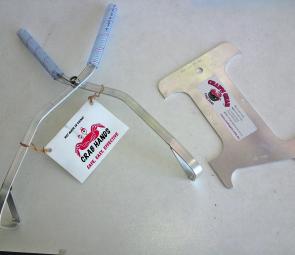
Two essential tools of the trade when catching crabs are the crab carapace measurer and the crab grab.
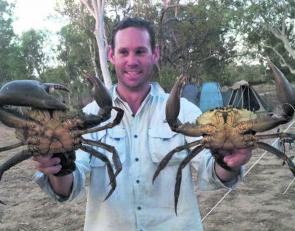
A good quality full crab will have a brownish appearance and a much harder thicker shell.
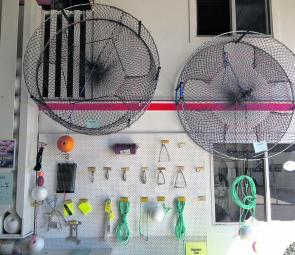
You can choose from a variety of crabbing gear. Just remember that quality is often reflected in the price tag and you will get what you paid for.
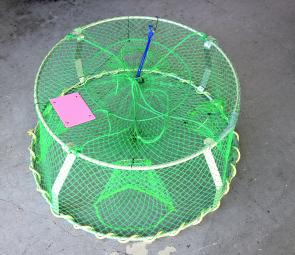
The four-entry quick lift red claw trap is taking over from the opera house pot.
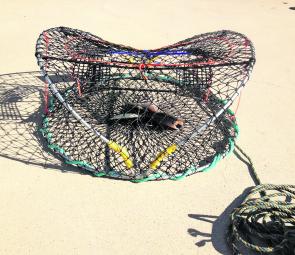
The Pup Pot, with its quick pop design and small strong build, suits anglers with limited storage space, such as kayakers and land-based fishers.




